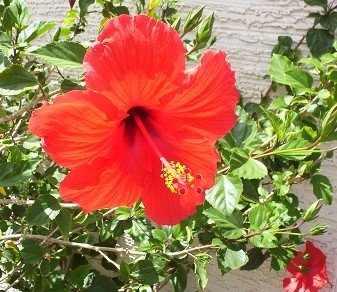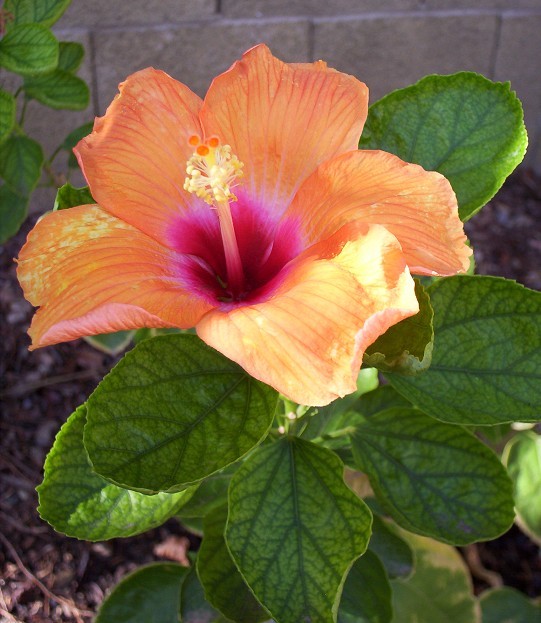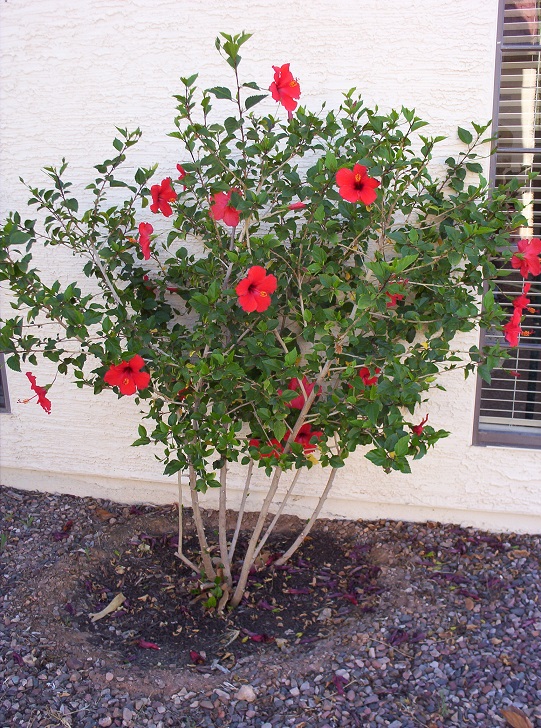|
 Photo
Photo
This photo of a hibiscus flower was taken in late April. The plant
has been in the ground for 4 years, and was planted on the East side of the house.
This variety of hibiscus is named Brilliant or San Diego Red, a type of tropical
hibiscus. Its flowers are 5.5 inches across and only open for a single day.
Although blossoms do not last long, the plant blooms continuously during warm and hot weather,
so it almost always has flowers on it.
While young, this hibiscus was allowed to grow as a shrub. Having lower branches helped protect it
from the sun and made it more stable in the wind. After four years it was trimmed up into a
multi stem form, which looks like a tree with multiple trunks.
Overview
Tropical hibiscus is fairly easy to grow in the Phoenix area. It takes the summer heat
well but is damaged when temperatures drop below freezing. It flowers almost all year and is especially productive
in spring.
|
On sale at Amazon! Flexzilla Garden Hose 5/8 in., Heavy Duty, Lightweight, Drinking Water Safe, ZillaGreen
|

|
Heat Tolerance and Sun Exposure
Tropical hibiscus take the summer heat well if regularly watered.
They will be more attractive overall if they receive afternoon shade, even though direct sun for part
of the day is necessary for flower production. Some varieties of tropical hibiscus take the heat
better than others. The San Diego Red pictured above tolerates sun better than the
Canary hibiscus shown below, which prefers a more shady location.

Cold Tolerance
Hibiscus start being damaged when temperatures drop to 29 F. Prolonged exposure to temperatures
at or below this will kill a hibiscus to the ground. However, a hibiscus will often be able
to grow back from its roots.
Planting
Dig a hole at least twice the size of the rootball. At a minimum, make the
hole 2 feet in diameter and 1 foot deep.
Work in a 50/50 mix of compost to soil.
Be sure to mix the compost and soil
as thoroughly as possible. It also is a good idea to finish with the
hole an inch or two recessed so that a watering basin is formed.
Watering frequency
Most of the year hibiscus do well on a grass watering schedule.
During winter the plant will be green but is almost dormant so it needs very little water and
can be switched to a citrus watering schedule. Watering a
hibiscus too much during winter will make it chlorotic.
Watering method
Basin or flood irrigation
is recommended because it helps keep the salt in our salty
water from accumulating around the roots. Furthermore, deep watering
will encourage the plant to develop deeper roots, making it tougher when the weather
gets hot and dry.

Fertilizing and Growth Rate
Hibiscus grow at a moderate rate and therefore consume a moderate amount of nutrients.
Organic methods can be used to keep them healthy and these methods can also be supplemented with small
amounts of chemical fertilizers. The simplest and most effective organic fertilizer is
compost which can be spread around the base of the plant at a depth of an inch. Slow release chemical
fertilizers are recommended, and varieties that also acidify the soil will help the plant look greener.
Propagation
Hibiscus are propagated from cuttings. See links below for more details.
Pests
Hibiscus have no significant pest problems in Arizona.
Links to more hibiscus information
American Hibiscus Society
Hibiscus Propagation
|
ORAVET Dental Hygiene Chew for Dogs, Vet-Recommended Daily Dog Dental Care Helps Reduce Tartar & Plaque (10-24 lbs.) 30 Count Daily Chews
|

|
|
 Book the Phoenix Tropicals Condo on Kiahuna Beach, in Kauai, Hawaii
Book the Phoenix Tropicals Condo on Kiahuna Beach, in Kauai, Hawaii